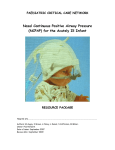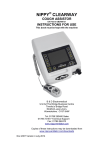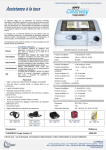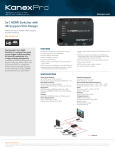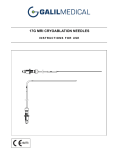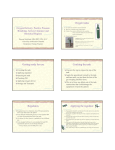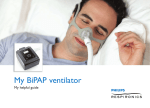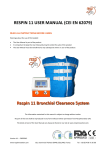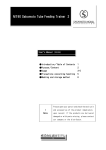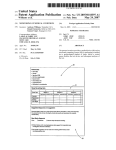Download NIPPY junior+ Quick Reference Guide
Transcript
DOC 0938c NIPPY junior+ Quick Reference Guide Nippy jnr+ may be used with: Tracheotomy ET Tube Full Face Mask Nasal Mask / Nasal Pillows Modes CPAP (Continuous Positive Airway Pressure) Pressure Support Spontaneous breathing supported by the ventilator. Back up in the absence of trigger. Pressure Control Timed inspiratory breath initiated by inspiratory trigger. Back up in the absence of trigger. IPPV Timed inspiratory breath initiated by inspiratory trigger. No EPAP. Back up in the absence of trigger. Alarms Power Fail Apnoea Alarm Low Internal Battery Max Breath Rate Low External Battery Breathing Circuit Malfunction Low Pressure High Pressure Breathing Circuit Disconnect High Flow alarm Low Flow alarm Fault These alarms may be muted for approximately 2 minutes. Low Internal Alarm/Memory Battery EXPLANATION OF CONTROLS 1 14 2 13 3 12 4 11 5 10 6 17 16 15 7 9 8 1. 2. 3. 4. 5. IPAP EPAP Ti Back up Mode - 6. 7. ◄- - 8. Set - 9. +► - 10. Mute - 11. 12. 13. 14. 15. - Menu Help Lo Alarm Hi Alarm Ext. Batt 16. Power 17. Start - Fascia Buttons Inspiratory Positive Airway Pressure adjustment Expiratory Positive Airway Pressure adjustment Inspiratory time adjustment Back-up Rate adjustment Mode selection Starts and Stops the ventilator Decreases the selected parameter or moves the selection bar down the menu. Selects the current menu function displayed by the selection bar. OR double press for battery run time and hours till next service. Increases the selected parameter or moves the selection bar up the menu Silences alarms for 2 minutes. Press and hold for 2 seconds to cancel mute. Menu screen Context sensitive help messages. Selects the Low Flow Alarm adjustment. Selects the High Flow Alarm adjustment. Indicates that ventilator is running on internal or external battery power. External power is connected. Indicates that the ventilator is running. 2 Fascia Display 3 2 4 8 4 9 4 5 6 7 1 12 1. 2. 3. 4. 5. 6. 7. Mode Pressure Display Rate Display Volume Display Flow Display Settings locked symbol Alarm Muted symbol - 8. I Trigger indicator - 9. E trigger indicator - 10. External battery - 11. Internal battery 12. Service Reminder - 11 10 Current mode of ventilation. Indicates airway pressure Indicates patient breath rate Indicates estimated inspiratory tidal volume Indicates airway flow Shows that the settings are locked. Audible alarm has been temporarily silenced. “Flashes” each time the inspiratory cycle is initiated by the patient. “Flashes” each time the expiratory cycle is initiated by the patient. Indicates external battery state of charge, when connected. Indicates internal battery state of charge Major service due 3 Getting Started To Switch On Press the Start/Stop button. To Switch Off Press the Start/Stop button. The “Switch Ventilator Off” message will appear onscreen. Press the Start/Stop button again after 2 seconds. There must be a delay of 2 seconds before each push, to prevent accidental operation. How to adjust the Nippy jnr+ Select the desired parameter with the relevant button. The reading adjacent to the button will be highlighted by a purple flashing box. Alter it with the ◄- or +► buttons. When you have finished, move on to the next adjustment or wait a couple of seconds for the flashing box to disappear. How to use the on-screen menu Press the MENU button. The menu window will be displayed in front of the main screen. Move the selection bar up or down the menu with the ◄- or +► buttons to highlight the desired function and press the SET button. Follow the on-screen instruction at the bottom of the window Press MENU at any time to exit and return to the main screen. How to use the On-screen Help Press the HELP button at any time for a list of help topics. Follow the simple on-screen instructions. Press HELP again to exit. If during setting up, you require a description of a particular parameter, select it then press HELP. Press HELP again to clear. Using Help with settings locked. When the settings have been locked, help is limited to a list of more common problems that may arise during use and advice on how to deal with them. SETTING UP THE NIPPY jnr+ Refer to the user manual for detailed set up instructions 4 Setting Up the Alarms The high and low flow alarms may be set automatically. It is vital that the alarms are tested after setting up. Low Flow Alarm • Allow the ventilator to cycle through several breaths before auto setting the alarm • Press and hold the Low Flow Alarm button • This setting may be further adjusted manually if required. • Test the alarm as detailed in “Alarm Conditions and Tests” section of the user manual. High Flow Alarm • Allow the ventilator to cycle through several breaths before auto setting the alarm • Press and hold the High Flow Alarm button • This setting may be further adjusted manually if required. • Test the alarm as detailed in “Alarm Conditions and Tests” section of the user manual. Warning! The auto set facility is not infallible. Varying leak can cause errors. The settings must be verified and the alarm function tested. If the alarm settings are not correct or the alarms do not operate when tested, proceed to the manual set up. Manual Setting Refer to user manual for detailed alarm settings Disconnection Alarm The disconnection alarm acts as a back up to the high flow alarm. There are three different sensitivity levels or it may be disabled if not required. High Sensitivity – Useful for very restrictive breathing circuits or small tracheotomy tubes. Standard Sensitivity – Default level. Used for almost all patients. Low Sensitivity – Useful where mask leaks cause nuisance disconnect alarms. Verify that patient is properly ventilated during these periods before using the Low setting. Disabled – Disconnect alarm is switched off. Useful where mouth breathing or excessive leak causes nuisance disconnect alarms. Verify that patient is properly ventilated during these periods before using this setting. Disconnection alarm relies solely on the High Flow alarm. 5 Apnoea Alarm Select USER PREFERENCES from the main menu. From the OPTIONS MENU, select APNOEA ALARM. To activate the apnoea alarm, select ON and select the required delay. The total number of apnoeas during the last seven days or since reset, will be displayed along with the time duration of the longest single apnoea. Press + and – together to reset the apnoea count. An apnoea is defined as a cessation of spontaneous breathing for the set time delay. Ventilation will continue at the backup rate during apnoea events. Max Breath Rate Alarm The max rate alarm will be activated if the patients breath rate exceeds the set level. Select USER PREFERENCES from the main menu. From the OPTIONS MENU, select RATE ALARM. To activate the rate alarm, select ON and set the required max rate. Testing the Alarms Always test the alarms before use. Refer to the user manual for detailed information. High Flow Alarm Disconnect the breathing circuit at the patient outlet port and allow the flow to exceed the set alarm value. The alarm will be activated after 5 seconds. Disconnect Alarm Disconnect the breathing circuit at the patient outlet port. The High Flow alarm will be activated after a delay of 5 seconds and will be replaced by the disconnect alarm after 10 seconds. Low Flow Alarm Occlude the outlet at the patient outlet port. The alarm will sound after 10 seconds. 6 Sigh. The ventilator can be programmed to deliver an occasional sigh with a larger tidal volume. This prevents collapse of the alveoli (atelectasis) which can result from the patient constantly inspiring the same volume of gas. Sigh is available in all modes except CPAP. The Sigh function provides a timed inspiration at the IPAP and TI settings specified in the Sigh Settings screen. Sigh may be set for cyclic operation, sigh breath at the specified interval or an external switch (Manual mode). Or a combination of both, where the cyclic sigh may be supplemented by extra sigh breaths on demand. Setting the Sigh function Press MENU and select USER PREFERENCES. In the User preferences screen select SIGH SETTINGS. Use the SET button to scroll down the settings, using the +/- buttons to alter the settings. Sigh Interval sets frequency of cyclic sigh Ext Trig = manual switched sigh Symbol S shows Manual Sigh function is enabled. Symbol Sc shows Cyclic Sigh function is enabled. Blue Symbol = Sigh mode enabled. Green Symbol = External sigh trigger acknowledged. Purple Symbol = Sigh breath activated. Sigh breath pressure (S) is indicated on the pressure bargraph display. Đ m Đ Note: If the ventilator IPAP is adjusted after the sigh has been set up, this may affect the sigh setting. If the IPAP is reduced the sigh will be reduced by the same amount, to maintain the difference between IPAP and Sigh. This can be overridden in the Sigh Settings screen. If IPAP is increased to a value equal to the sigh setting, the sigh value will “track” the IPAP. This effectively makes IPAP and Sigh the same. This is done to prevent accidental increase of the sigh breath. The sigh will need to be reset in the Sigh Settings screen. Sigh is cancelled when Mode is changed. The IPAP during Sigh cannot be lower than normal IPAP. Regardless of the back up rate, a sigh breath is timed with an IE ratio of 1:2. This does not affect triggering. High flow and disconnect alarm is suspended during Sigh. No more than 5 consecutive sigh breaths are allowed. 7 Running the Nippy jnr+ on Battery Power Refer to user manual for detailed description / instructions. When connected to mains, the ventilator will recharge its own internal and/or external battery. Leave connected to the mains supply in between periods of use to keep the batteries charged or to recharge ready for the next use or to recover a deeply discharged battery. The ventilator will select its power source, in the following sequence:1. – Mains Electricity 2. - External Battery (if connected) 3. – Internal Battery (if fitted) Battery icons The battery icons on the main screen indicate a number of things relating to the batteries:INT icon shows that an internal battery is fitted. INT will flash when running on internal battery. The green bottom section indicates the amount of charge remaining. A flashing yellow top section indicates that the external battery is charging. EXT icon shows that the recommended external battery is connected. EXT will flash when running on external battery. The green bottom section indicates the amount of charge remaining. A flashing yellow top section indicates that the external battery is charging. EXT icon with a black fill shows that an alternative external battery is connected. The state of charge cannot be displayed. The ventilator cannot charge this type of battery. Run Time Indication To check remaining run time, double press the SET button whilst running on battery power. The screen will show an estimate of running time based on the current state of charge and settings. Low Battery Alarm When the battery is depleted an alarm will sound, accompanied by an on screen message, “Battery Power Running Low” When battery power reaches a critical level, the alarm will change to a continuous tone and the on-screen message will change to “Battery Power Exhausted. About to switch off. Connect to Mains Power Now” After auto power off, the alarm will continue until the Mute is pressed. 8








